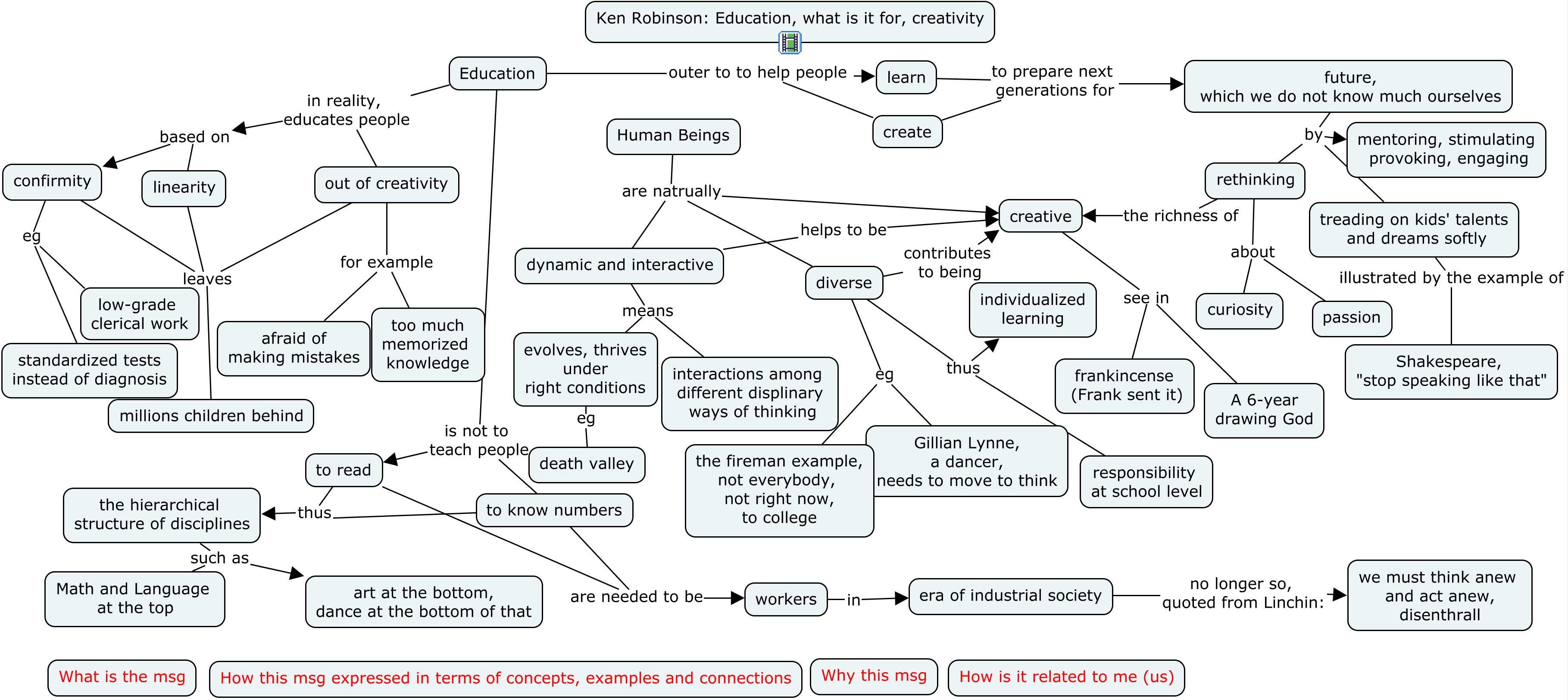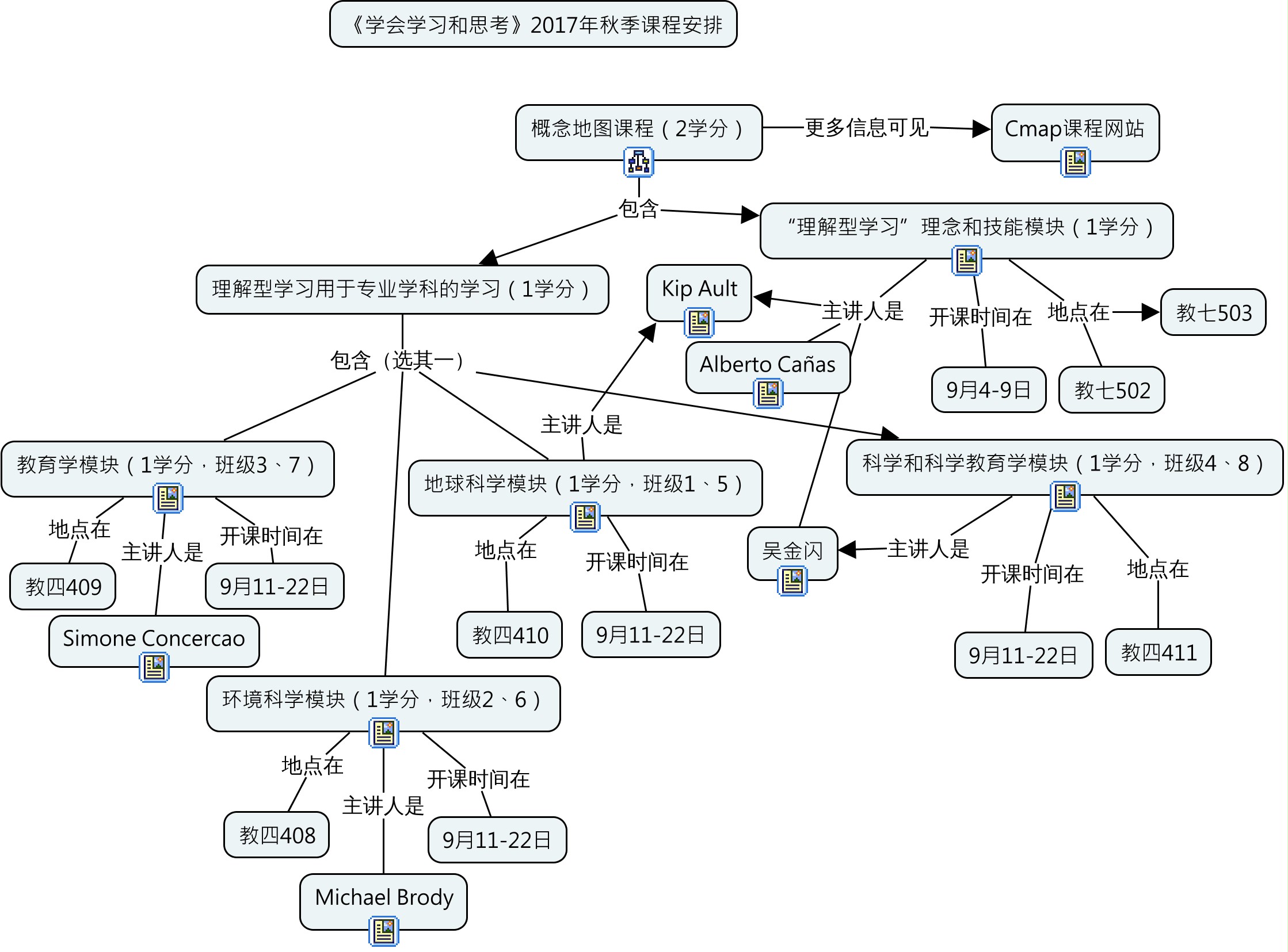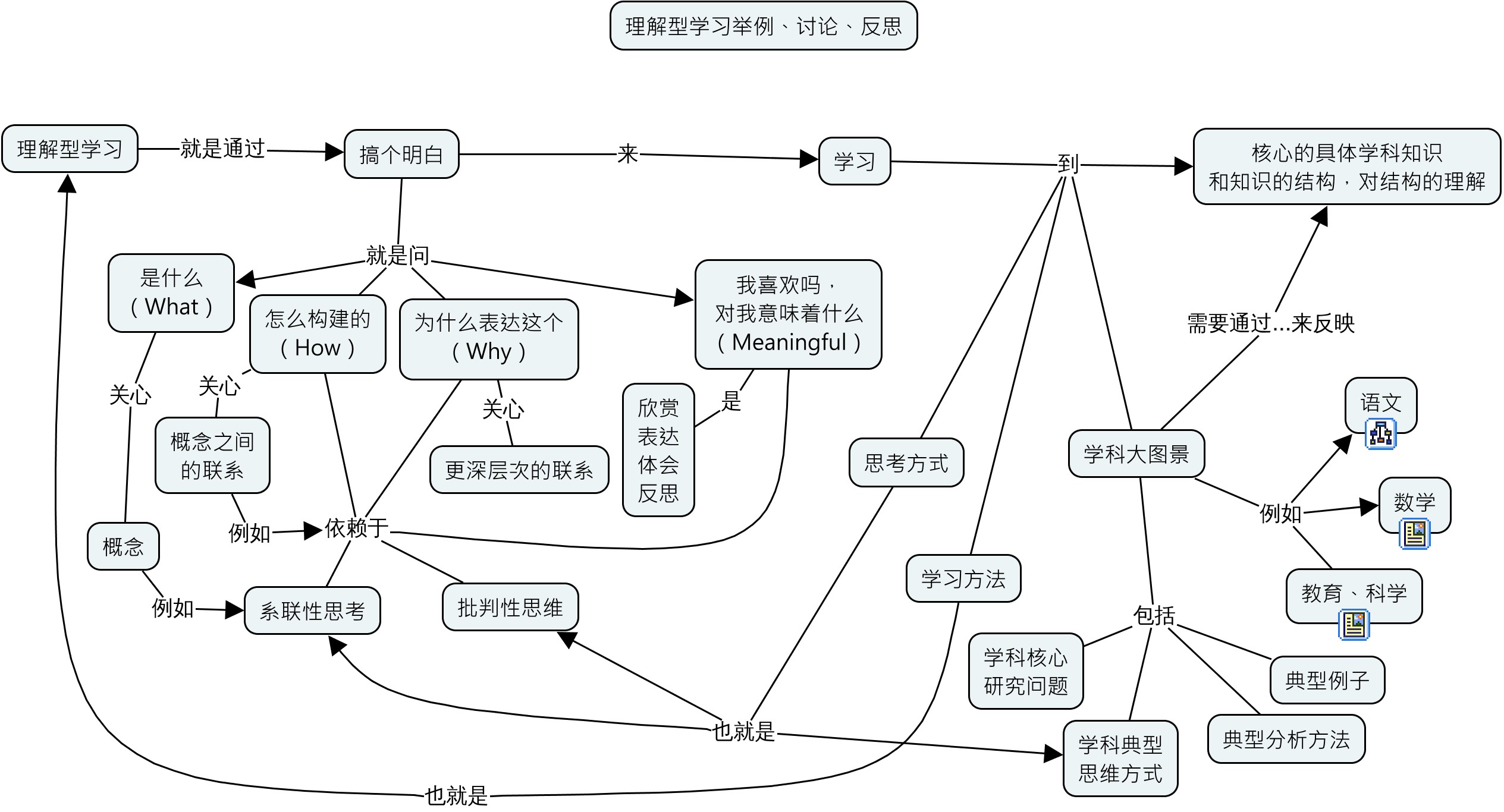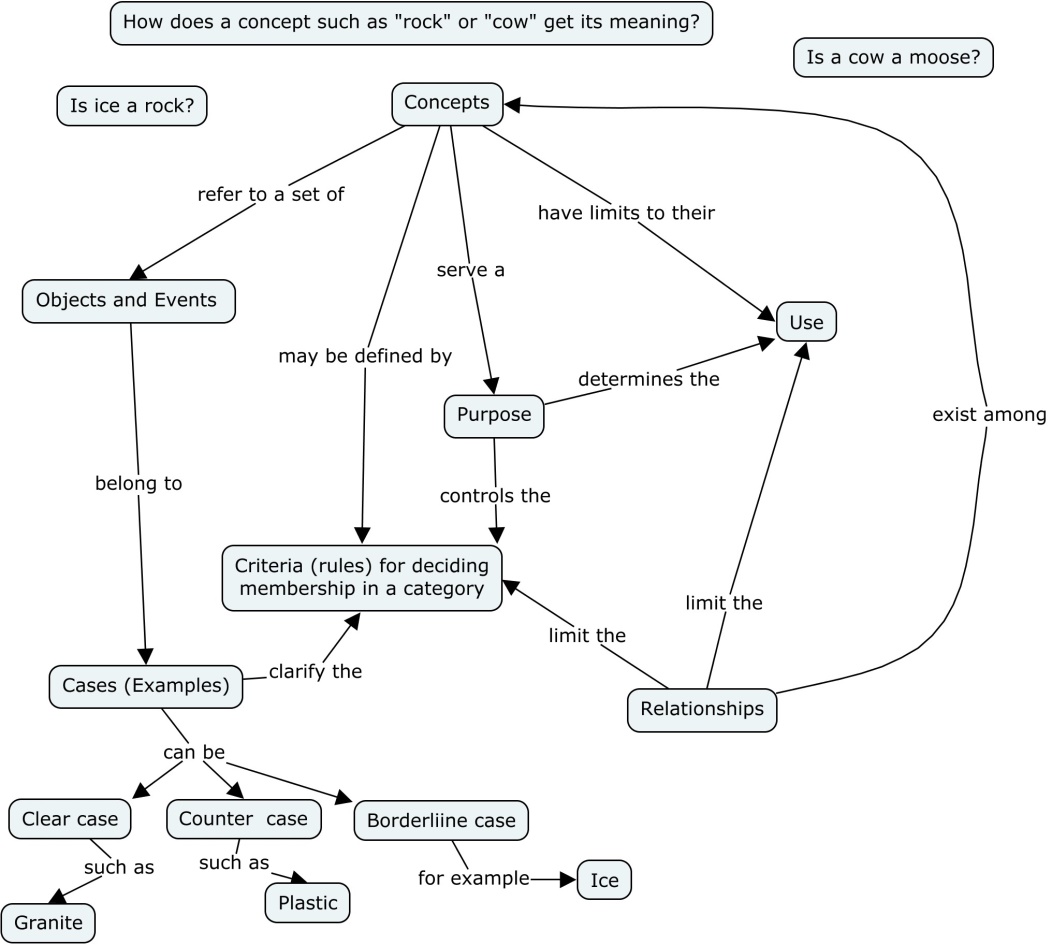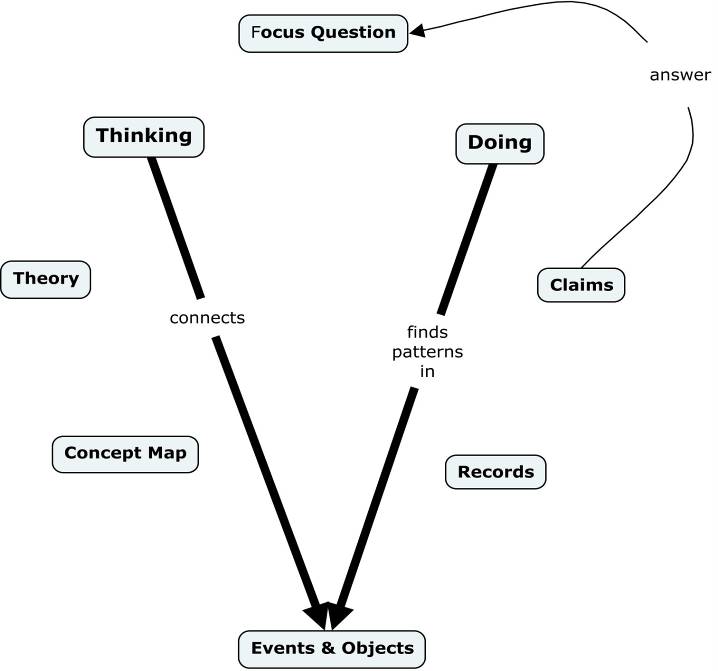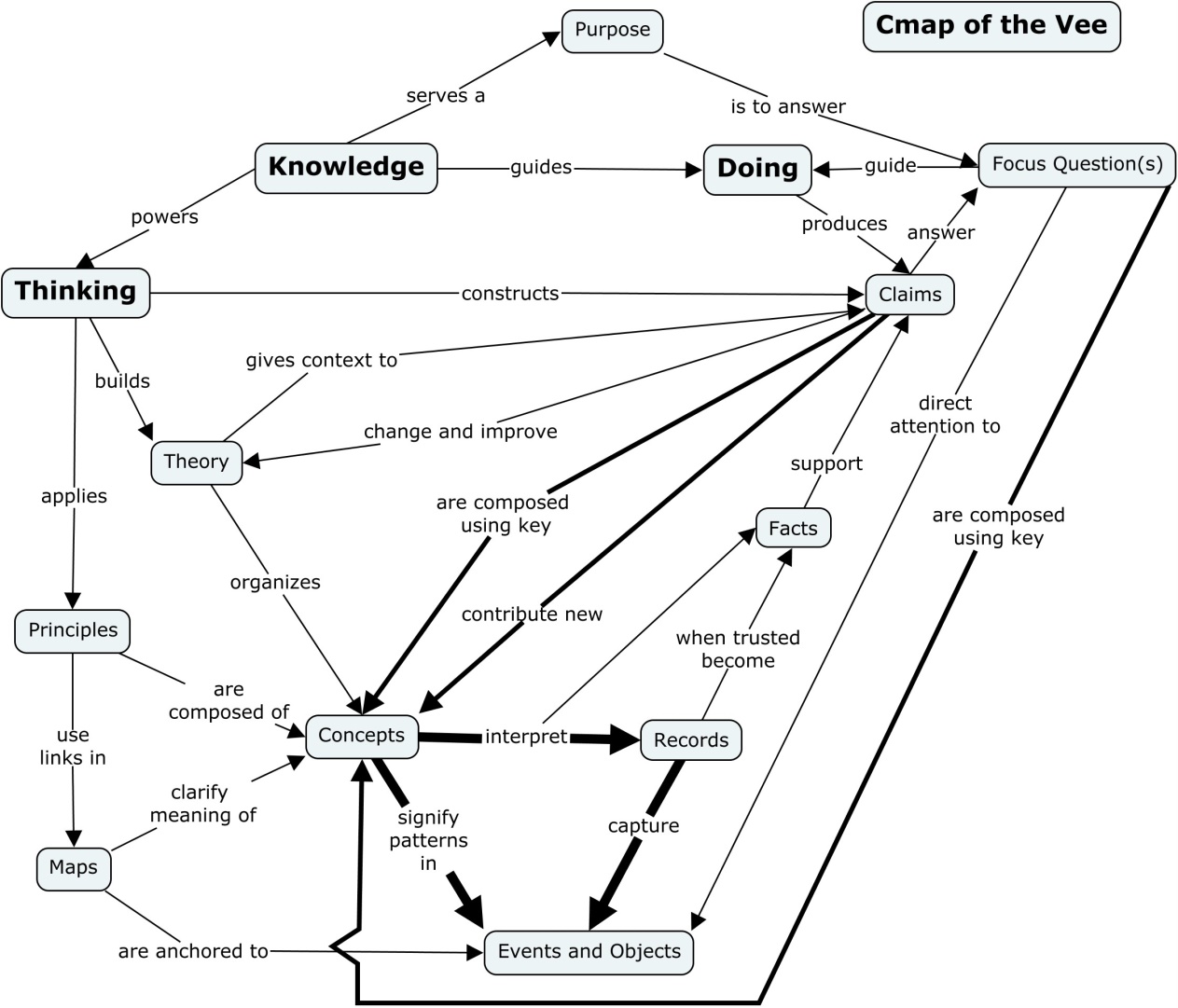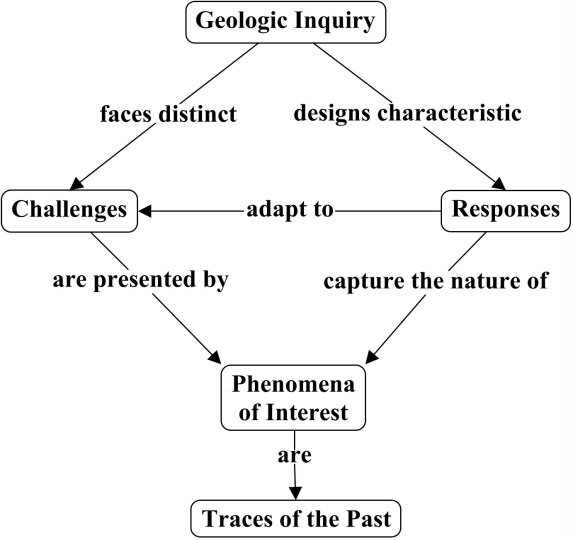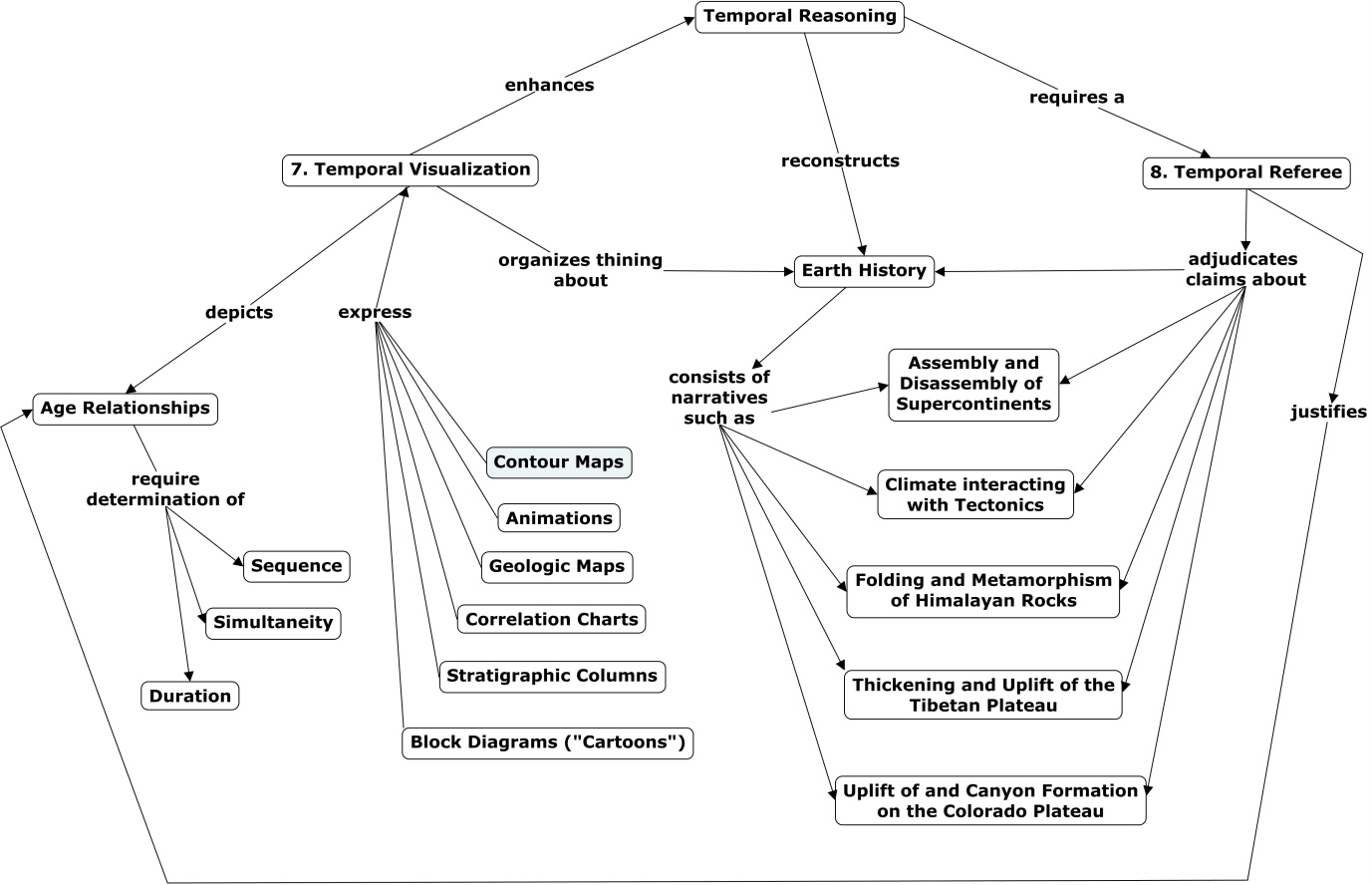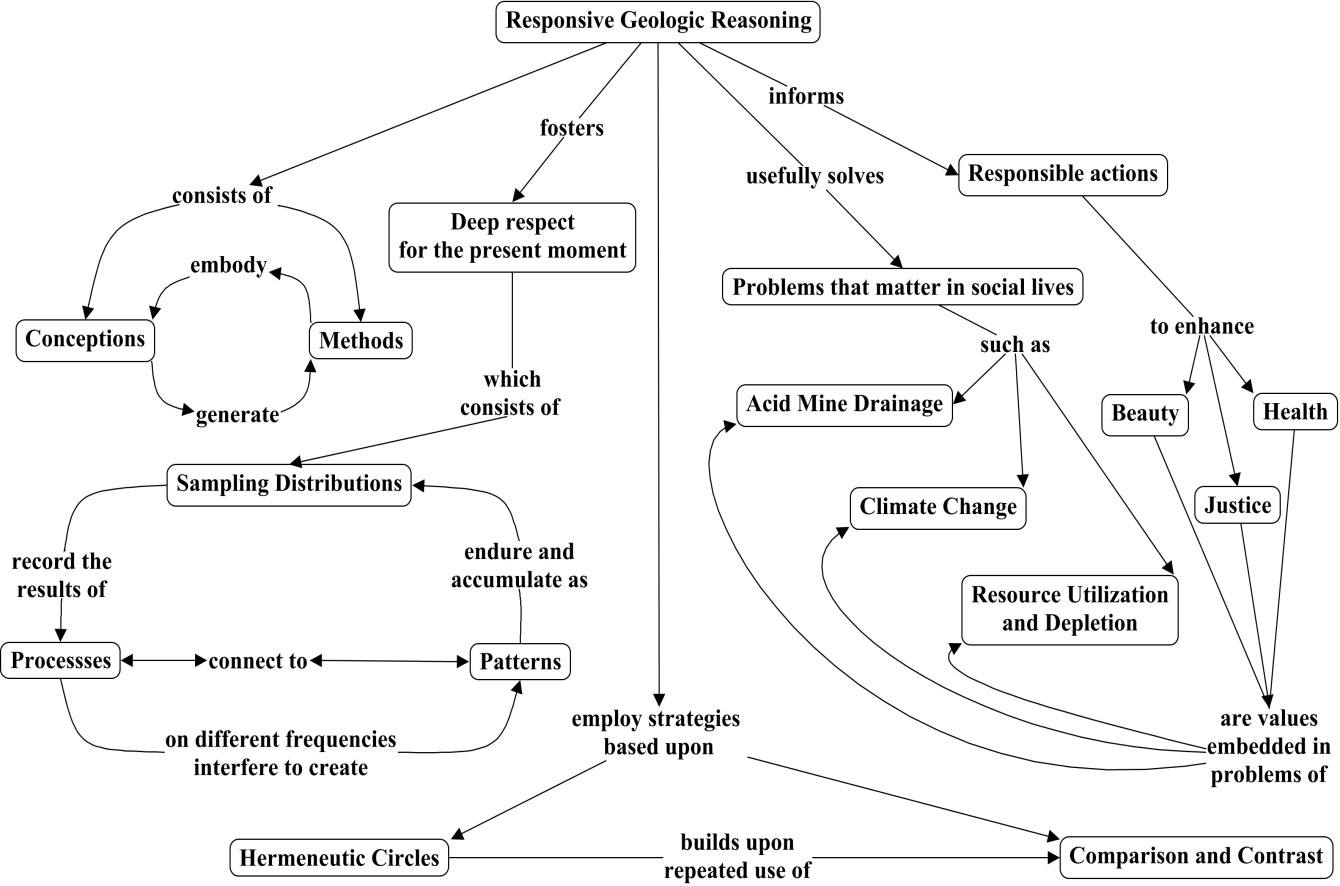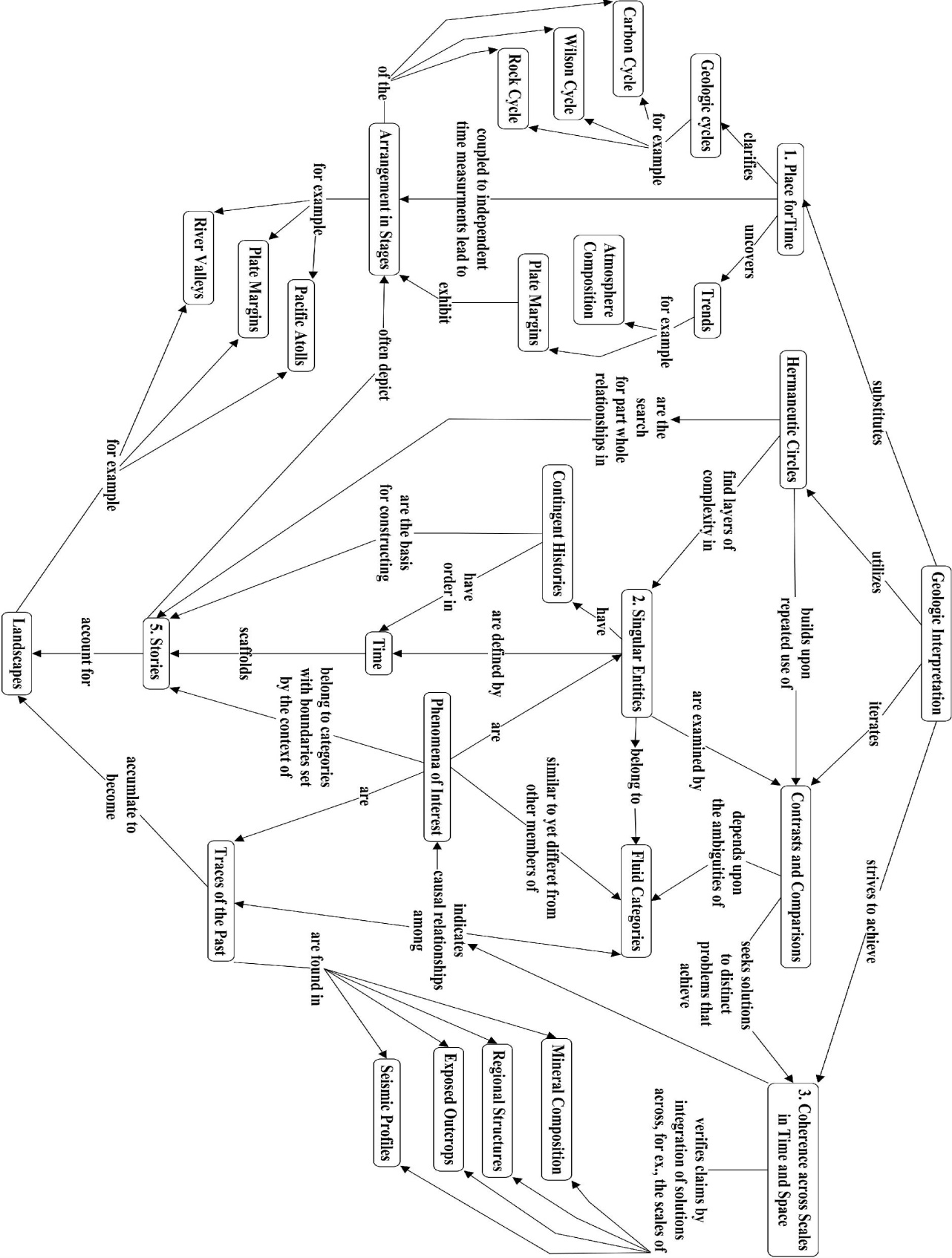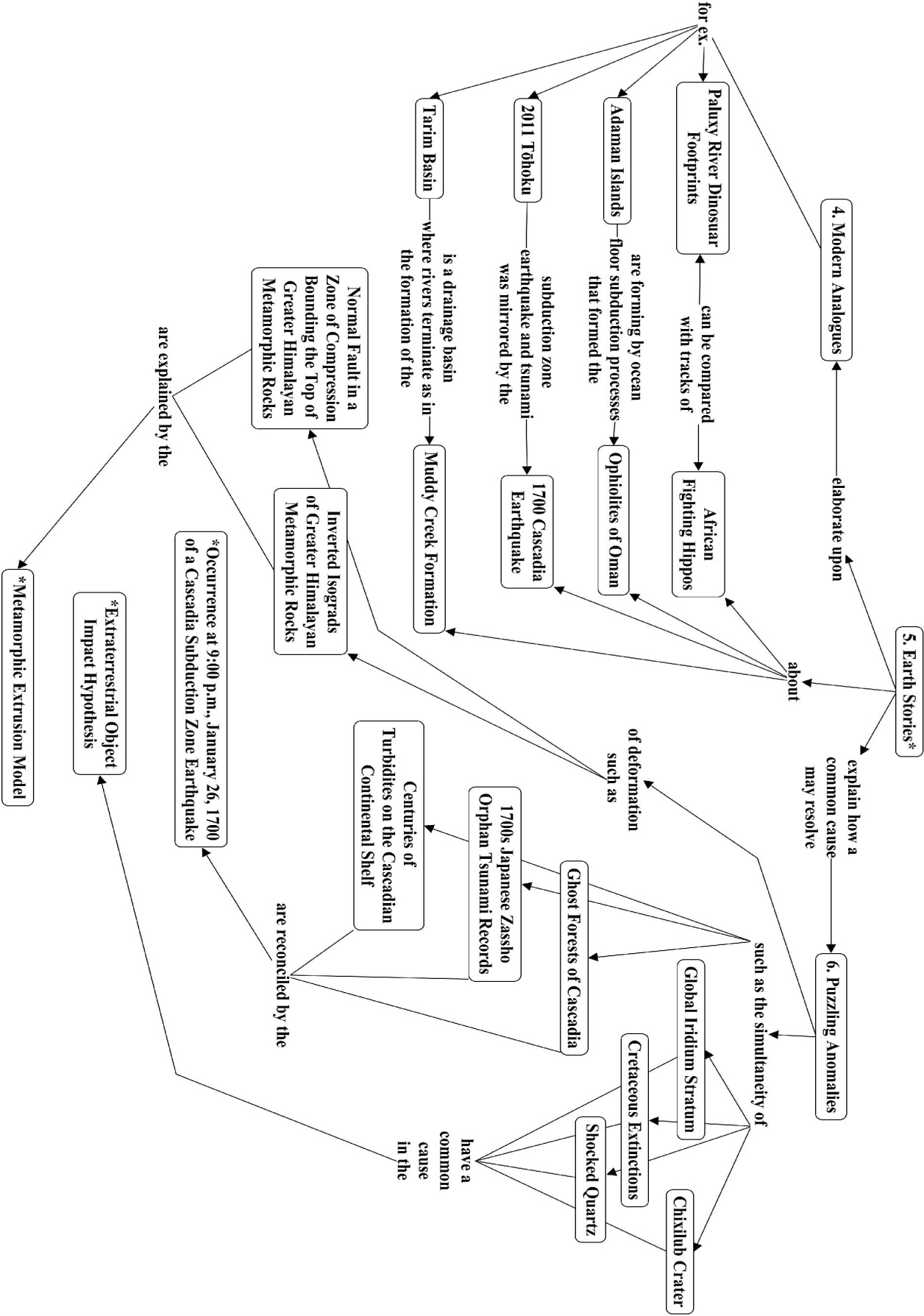按照Teach Less, Learn More课程体系的一般设计要求和《学会学习和思考》的设计原则,我们做了《学会学习和思考教育学模块》的设计。
教育学模块整体的概念地图
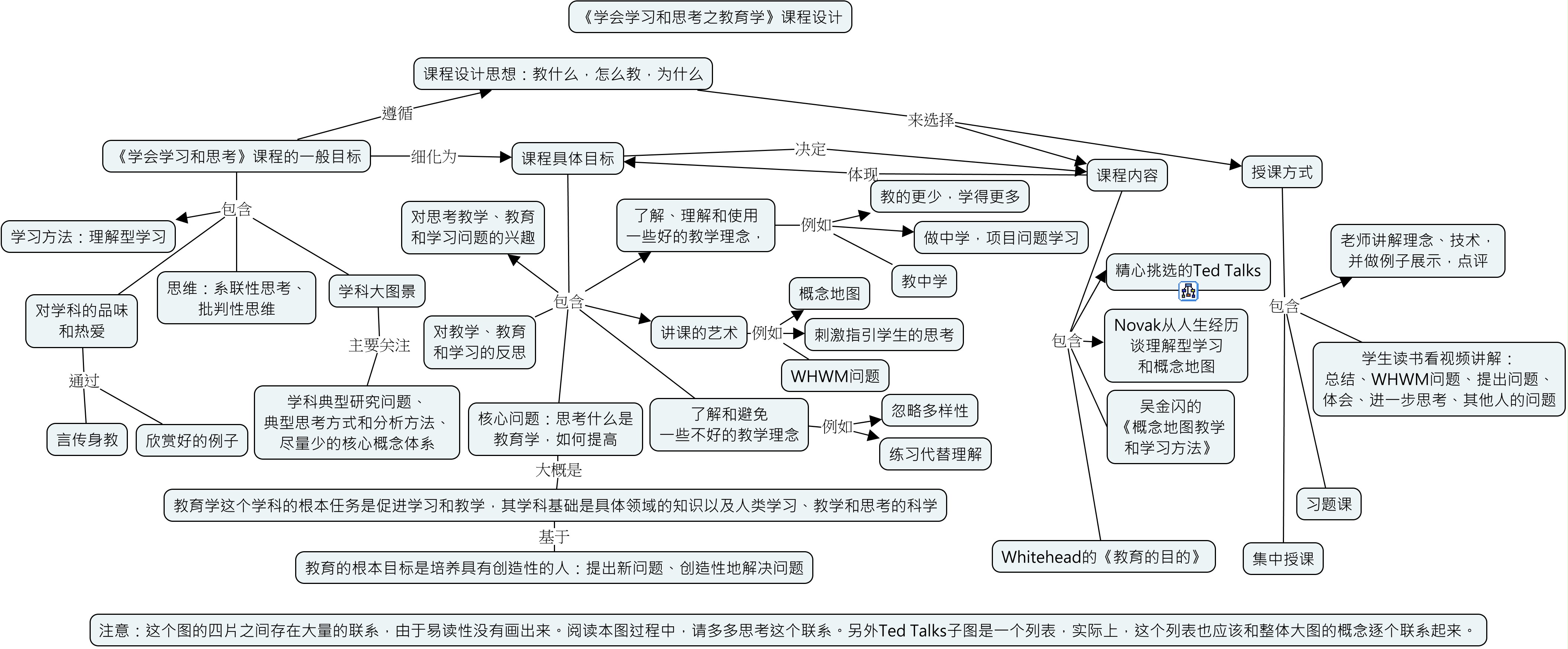
课程目标:
1、刺激和引导学生思考什么是教育学,如何做更好的教育
2、学生可以有自己的思考和理解,但是大概来说:教育学这个学科的根本任务是促进学习和教学,其学科基础是具体领域的知识以及人类学习、教学和思考的科学。
3、了解和实践教育中一些好的理念:系联性思考、批判性思维、做中学、从教(同伴)中学习、项目和问题为基础的教学、粗糙问题的价值、教的更少学得更多(关注大图景——学科基本问题以及和现实的联系、典型研究思想和分析方法、核心概念以及它们之间的联系,问理据性等WHWM问题(W:什么是主要信息,H:这个信息如何通过概念例子以及它们之间的联系来表达,W:为什么你想表达这个信息,M:这个信息对于我还有这个世界意味着什么?),刺激挑战引导学生和学生平等讨论(让学生问他所想问,说他所想说)。
4、了解和避免一些教育中的一些不好的理念:用重复练习来代替对概念理解的深化、用忽略学生多样性的固定套路来禁锢学生的思考和创造性、仅仅关注抽象成模型或者数学问题以后的世界而忽略抽象化的重要性、按照习惯的教材或者教法来教学而不反思其理据性。
5、对构建真的能够解决主要任务的教育学的兴趣
6、学习和教学能力的提高。
7、在学习和思考“教育学”的过程中实践系联性思考、批判性思维,学会学习和思考。
学习材料:
1、Ted Talks视频:
Ken Robinson: Changing education paradigms,Ken Robinson教育的问题和出路四重奏,创造性和现代教育的目的
Ken Robinson: How to escape education’s death valley
Ken Robinson: Bring on the learning revolution!
Ken Robinson: Do schools kill creativity?
Arthur Benjamin: Teach statistics before calculus!,按照其他人或者教科书来教学吗?
Tim Brown: Tales of creativity and play,创造力和玩
Cameron Herold: Let’s raise kids to be entrepreneurs,创业者的特质和培养
Chris Anderson: Questions no one knows the answers to,好奇心、科学和教育
Christopher Emdin: Teach teachers how to create magic,教学本身需要创造性
Clint Smith: The danger of silence,让每个人都问你所想问,说你所想说
John Green: The nerd’s guide to learning everything online,思考改变世界,人生就是探索未知世界
Liz Coleman: A call to reinvent liberal arts education,什么是真正的通识教育
Patrick Awuah: How to educate leaders? Liberal arts,通识教育和社会
Marcus du Sautoy: Symmetry, reality’s riddle,世界中的数学,尤其是对称性
Cédric Villani: What’s so sexy about math? ,数学描述世界超越简单经验
Roger Antonsen: Math is the hidden secret to understanding the world,关于“理解”和数学,以及数学作为现实的表示
Hans Rosling: Let my dataset change your mindset,数学可以很有趣并且改变你的思想
Conrad Wolfram: Teaching kids real math with computers,数学的四个阶段(提出问题、抽象化、计算求解、验证和提高)和当前数学教育以及可能的解决方案
Dan Meyer: Math class needs a makeover,数学教育和粗糙问题的关系
Alan Kay: A powerful idea about ideas,精心设计的神奇的任务和计算模块帮助学习数学和科学
Victor Rios: Help for kids the education system ignores,教学和教育中的心理建设,信任的力量,帮助的力量
Carol Dweck: The power of believing that you can improve,教学和教育中的心理建设,鼓励的力量
John Wooden: The difference between winning and succeeding,赢和成功和教育的关系
Kiran Sethi: Kids, take charge,让孩子来当家做主改变世界
Sal Khan: Let’s teach for mastery — not test scores,网络课程Khan学院的学习模式
Anant Agarwal: Why massive open online courses (still) matter,网络公开课和现代教育
Andreas Schleicher: Use data to build better schools,能力和潜力能够检测吗,检测结果能够用来促进教学吗?
Daphne Koller: What we’re learning from online education,网络公开课和现代教育
Peter Norvig: The 100,000-student classroom,网络公开课和现代教育
Sal Khan: Let’s use video to reinvent education,网络课程Khan学院和现代教育
Richard Baraniuk: The birth of the open-source learning revolution,网络公开课和现代教育
Peter Doolittle: How your “working memory” makes sense of the world,脑科学如何帮助学习和教学
James Flynn: Why our IQ levels are higher than our grandparents’,IQ在检测什么这个什么和科学的关系
Takaharu Tezuka: The best kindergarten you’ve ever seen,建筑改变行为和思维并促进学习和成长
2、Joseph Novak: Life experience and meaningful learning,通过Novak自己的生活经验来更好地理解概念地图、理解型学习
3、吴金闪《概念地图教学和学习方法》
4、参考书:Whitehead《教育的目的》、Novak《学习、创造与使用知识——概念图促进企业和学校的学习变革》
先修课:
《学会学习和思考》技能训练模块,或者其他经过我们认可的概念地图和系联性思考培训班
课程形式和教学安排:
在两周的时间内每周三次每次三小时集中上课,三小时老师授课(分享理念、举例子、讨论),学生看视频做30分钟口头报告和讨论教学。每周的另外两个晚上同样三小时用于习题课。
第一次课
老师授课(讨论形式),内容:提出什么是教育学,如何提高的问题。介绍课程基本信息(课堂形式、作业、考试、评分、课程目标、对学生的要求、课程负担、课程网站、习题课、助教等)。分享“教的更少,学得更多”的理念,突出系联性思考和批判性思维。学生选择学习材料。
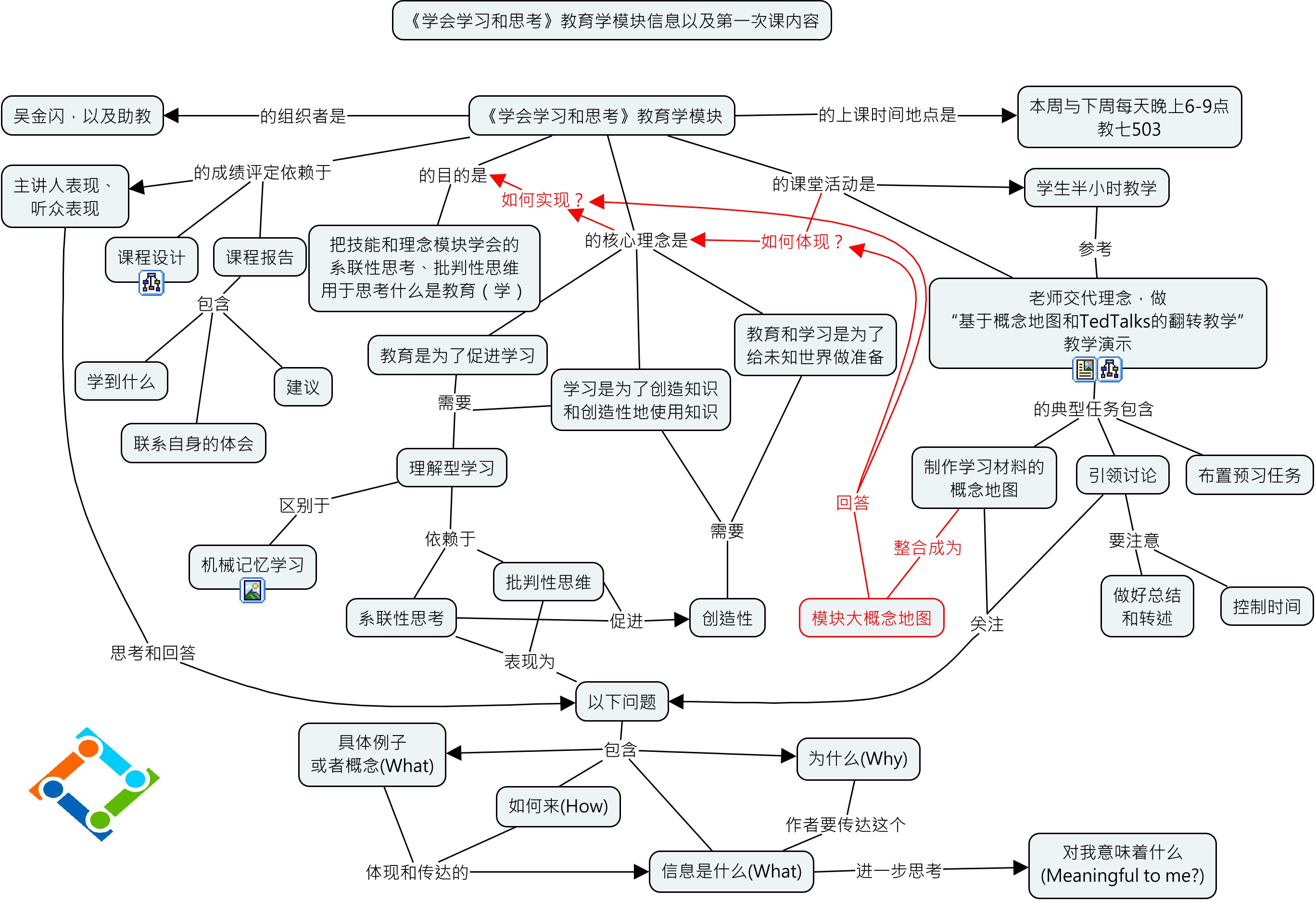
第二次课
老师选择某个视频,做一次演示教学。突出第一次课里面的理念以及阵对具体问题做好WHWM问题的讨论。剩余时间,按照第一次课结束之后学生选择的内容和顺序开展报告和讨论。
第三-五次课
按照学生选择的内容和顺序做报告、讨论和点评
第六次课
按照学生选择的内容和顺序做报告、讨论和点评。剩余时间,老师做总结,提示思考这些视频之间的关系,以及这些视频和课程目标——思考什么是教育学,如何提高——之间的关系。布置好最后的作业。总结大家表现出来的好的地方和主要问题。
对学生的要求:
熟练的英语听说(课程为全英文授课)、对教育感兴趣并且有一个开放的头脑还要愿意接受理念和学习难度学习方式上的挑战
课程主要作业:
看所有的视频,选择其中的一个按照WHWM来做基于视频的“关于什么是教育学如何提高”的报告,按照“Teach Less, Learn More”的原则完成一门课的课程设计,完成课程报告——总结课程学到的内容并反思
课程工作量:
上正课时间每天3小时(3*6=18小时),习题课时间每天3小时(4*3=12小时),课后看所有的视频(约20小时)和书(约6小时),为口头报告做准备(基本在习题课时间完成),完成课程设计作业(约10小时),完成课程学习报告(约10小时)。课后思考,相信我肯定会有很多,时间不可计。
注意:课程配有助教,习题课不强制要求参加但是会大大缩短你准备的时间和提高你学习的效果
警告:本课程需要你大量的时间和精力的投入,做主动学习,而不是听听课而已。如果你做不到,或者你对记忆型学习非常满意,请不要来选择这门课程。
每一项具体教学内容的概念地图和理据性:
0、在本课程中,学生学习过程中整理了各个学习材料的概念地图,可供参考。另外,理据性部分仅仅举了两个例子。实际上,这两项工作应该先由课程设计者做完。
1、为什么采用教师分享理念举例学生讲解同学老师点评的方式来授课
教育学科是一个很特殊的发展非常不成熟的学科。一个真正的能够完成这个学科的任务——提高学习和教学的效率——的科学理论体系还没有建立起来。另一方面,问题是明确的:为了培养更好的创造者——提出问题、创造知识或者创造性地运用知识的人——确实有很多东西需要学和教;然而目前的教育系统基本上是基于培养熟练工人——能够识字能够数数能够执行命令——来构建的。从这个角度来说,教育学的基础应该是具体学科的知识结构和认知科学。但是,一方面教育学的理论和研究工作没有很好地基于具体学科的知识结构,另一方面,认知科学的发展也没有成熟到能够直接帮助和指导学习和教学的程度。那么,教育学怎么教?难道系统性的理论没有,连可以借鉴的好的理念也没有吗,连可以借鉴从而避免的的不好理念也没有吗?有,好的和不好的都有。没有理论,有一些经验和理念,那么,课堂怎么教?
借鉴好的教育学理念,对于操作性比较强,系统性理论性不够强的内容,采用做中学(Learning by doing),教中学(Learning by teaching)。于是,老师的责任就是引领道路和引领思考,分享完理念之后,做一个演示教学,然后在点评中进一步体现理念。同时,学生口头报告中暴露出来的问题会比老师专门设计出来的问题和场景更好地成为大家讨论学习的材料。
2、为什么教“Teach Less, Learn More”
很多的老师的教学行为是按照其他人怎么教或者某一本或者几本教科书来进行的。来很多时候,没有深入地思考过是否每一个教学内容都是有必要的,为了实现某一个目的并且这个目的有利于培养真正的提出问题、创造知识或者创造性地使用知识的人的。随着我们所积累的知识的量的增加和技术的进步,单纯为了存储知识的学习基本上已经没有必要了。进一步,如果什么东西都要按部就班来学,那么,在我们真的能够创造知识之前我们就必须花费越来越多的时间来学习。有没有什么办法,能够用尽量少的具体知识作为学习内容可是学习得到的对这个学科的理解又能够比较深刻,明白这个学科的大图景:典型问题、典型思考方式和典型分析方法呢?有,把握住这个学科的核心概念体系——概念、举例以及它们之间的关系,然后选择能够体现大图景的概念、举例和它们之间的关系来作为学习内容,把非核心和基础的内容留给学生自学(例如通过布置作业)。
这样的一个体系就是我们称之为“教的更少,学得更多”的体系。它的主要教学目标是学会这个学科的大图景——典型问题、典型思考方式和典型分析方法还有核心概念体系,让学生能够进一步自学——所以也学会使用系联性思考和批判性思维,愿意进一步自学——所以要用教师自己对这个学科的情感来感染学生。为了实现这个目标,对于一门课程,老师需要明确写下来:教学的目标(按照上面的一般目标来细化),整体知识结构的概念地图,选择的核心概念和典型例子的子概念地图,每一项教学内容的理据性,教学过程中一定要问好WHWM问题促进学习者对大图景和小问题的理解。
3、为什么要选择Ken Robinson的关于学校教育和创造性的视频
为什么在新的时代下我们的教育要改变,如何改变?之前的教育再什么地方做得不够好?在Robinson的四个Ted Talks里面,他主要讨论了这个问题。他认为问题的关键在于目前的学校教育和创造性之间的冲突。发源于机器大工业时代的现代教育系统当年是为了培养熟练工人,但是今天,我们识字和能算的问题已经基本解决了。这个时候,我们要怎么做才能保护和培养学生的创造性?
